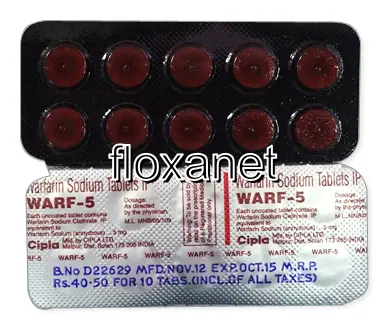| Package | Dosage | Price | Price per Dose | |
|---|---|---|---|---|
| Dosage: 1mg | ||||
| 360 pill | 1mg | €212.55 | €0.59 | |
| 180 pill | 1mg | €116.90 | €0.65 | |
| 120 pill | 1mg | €87.38 | €0.73 | |
| 90 pill | 1mg | €69.66 | €0.78 | |
| 60 pill | 1mg | €50.77 | €0.84 | |
| 30 pill | 1mg | €27.15 | €0.91 | |
| Dosage: 2mg | ||||
| 360 pill | 2mg | €255.07 | €0.71 | |
| 180 pill | 2mg | €138.16 | €0.77 | |
| 120 pill | 2mg | €99.19 | €0.83 | |
| 90 pill | 2mg | €80.29 | €0.90 | |
| 60 pill | 2mg | €60.21 | €1.00 | |
| 30 pill | 2mg | €34.23 | €1.16 | |
| Dosage: 5mg | ||||
| 360 pill | 5mg | €284.59 | €0.79 | |
| 240 pill | 5mg | €200.74 | €0.84 | |
| 180 pill | 5mg | €167.68 | €0.93 | |
| 120 pill | 5mg | €127.53 | €1.06 | |
| 90 pill | 5mg | €106.27 | €1.18 | |
| 60 pill | 5mg | €72.02 | €1.19 | |
| 30 pill | 5mg | €37.78 | €1.26 | |
| 20 pill | 5mg | €27.15 | €1.33 | |
| 10 pill | 5mg | €12.98 | €1.35 | |

Warfarin Description
Overview of Warfarin
Warfarin is a widely used anticoagulant medication that helps prevent and treat blood clots. It is often prescribed for patients at risk of developing conditions such as deep vein thrombosis (DVT), pulmonary embolism (PE), or after certain surgeries to reduce the risk of clot formation. As an oral medication, warfarin is known for its effectiveness in managing blood clotting issues, but it requires careful monitoring to ensure safe and efficient therapy.
How Warfarin Works
Warfarin works by inhibiting the synthesis of vitamin K-dependent clotting factors in the liver. These factors include factors II, VII, IX, and X. By reducing the levels of these proteins, warfarin slows down blood clotting processes, making it less likely for clots to form. This mechanism helps prevent the development of life-threatening conditions such as strokes or heart attacks caused by blood clots. However, because of its mechanism, warfarin’s effects need to be precisely controlled to minimize the risk of excessive bleeding or clotting.
Usage and Dosage
The prescribed dosage of warfarin varies based on individual patient factors, including age, weight, kidney and liver function, and the reason for treatment. Typically, physicians start with a low dose and adjust based on regular blood tests called INR (International Normalized Ratio). INR monitoring is crucial to maintaining the therapy within a therapeutic range, generally between 2.0 and 3.0 for most conditions. Patients are required to follow their healthcare provider’s instructions precisely and avoid sudden changes in diet or medication that could affect warfarin’s efficacy.
Advantages of Warfarin
One of the main advantages of warfarin is its proven track record over decades of use. It is an effective medication for long-term anticoagulation therapy. Additionally, it is widely available and relatively inexpensive. Its dosing can be tailored to each patient, allowing for personalized treatment plans. For many patients, warfarin remains the preferred choice because of its extensive clinical experience and well-understood pharmacology.
Side Effects and Precautions
The most significant concern with warfarin is the risk of bleeding. Patients may experience minor bleeding like bruising or nosebleeds, but serious bleeding can occur if INR levels become too high. Other side effects might include nausea, vomiting, or skin rash, but these are less common. It is essential to inform your healthcare provider immediately if you notice unusual bleeding, severe headaches, or blood in urine or stool. Patients should also avoid activities that increase bleeding risk and be cautious about taking other medications or supplements that may interfere with warfarin’s action.
Interactions and Dietary Considerations
Warfarin interacts with many medications, including antibiotics, antifungals, and certain pain relievers. These interactions may enhance or reduce its effectiveness, necessitating closer INR monitoring. Dietary vitamin K intake significantly influences warfarin's action. Foods rich in vitamin K such as green leafy vegetables can decrease warfarin’s anticoagulant effect. Patients are advised to maintain a consistent intake of vitamin K and discuss any dietary changes with their healthcare provider to ensure effective therapy and minimize fluctuations in INR levels.
Final Thoughts
Warfarin remains a cornerstone in anticoagulant therapy due to its proven efficacy and long history of use. However, it requires diligent management and regular blood testing to keep therapy within safe and effective limits. Patients on warfarin should have clear communication with their healthcare team, adhere to dosing instructions, and be aware of potential interactions. Proper education and monitoring are vital to maximize benefits while minimizing risks associated with this medication.
